Museum : Gombrowicz
Museum About institution
THE PALACE AND THE ESTATE
The Witold Gombrowicz Museum is housed in a small palace built in 1914. During the interwar period it belonged to the writer's sister-in-law, Aleksandra Gombrowicz. The building, in classical style with Secession elements, was designed by August Furuhjelm, an architect of Finnish origin, and commissioned by Jakub Grobicki, the owner of Wsola at the time. In 1920 it became the property of Maria Pruszak, who lent it in 1924 to her niece, Aleksandra, the wife of Jerzy Gombrowicz, the writer's older brother. In 1929 Aleksandra legally became the owner of the estate. The palace was enjoyed by the family until 1941, when the estate was occupied by the Nazi Liegenschaft.
After the war the estate was confiscated by the State Treasury for use in the plan for agricultural reform. Various state institutions were located in the palace, including a militia headquarters, later a home for special needs patients, as well as a center for social assistance for children and adults. In 2005 the Radom District sold the palace, together with six hectares of the park, to the Mazovian Province, which then transferred it to the Museum of Literature in Warsaw, designating it to house the Witold Gombrowicz Museum.
The building was in poor condition and thus a total renovation was undertaken in 2006, a difficult task that continued with interruptions until September of 2009. The Mazovian Province allotted nearly 6 1/2 ml. zl for the purchase and renovation of the Museum building.
Located 90 km from Warsaw and 10 km from Radom, the Witold Gombrowicz Museum opened to the public on October 14, 2009.
MUSEUM ACTIVITY
The Museum was opened on October 10, 2009 in the presence of Rita Gombrowicz, the writer's widow. Its mission includes the dissemination of knowledge about the writer's life and work; the initiation, presentation, and documentation of Gombrowicz-related projects; the collection of Gombrowicziana; the stimulation of intellectual and literary life, in both the field of education as well as the promotion of talent. The Museum offers access to its reading room containing works by Gombrowicz, translations, and secondary works. As a literary environment, the Museum is an institution open to other spheres of art and culture.
It is not only the permanent exhibitions relating to the life and work of Gombrowicz that attract visitor, but also a variety of artistic and intellectual events.
Every year we organise International Gombrowicz Panels. Participants thus far have included Rita Gombrowicz; the distinguished translator of Polish literature, Danuta Borchardt (USA); Bożena Zaboklicka (Spain); Olaf Kuhl (Niemcy); Lajos Palfalvi (Hungary; Anders Bodegard (Sweden); Jerzy Jarniewicz; Marta Jordan; literary specialists and critic Prof. Jerzy Jarzębski; Prof. Roman Loth; Kazimiera Szczuka; Jean-Pierre Salgas; Miguel Grinberg; Piotr Kłoczowski; Jacek Wakar; Wojciech Majcherek; Mariusz Wilk; Bronisław Świderski; and Zbigniew Kruszyński.
Other guests have included actors such as Andrzej Seweryn, Jan Nowicki, Krzysztof Globisz, Adam Ferency, Teresa Lipowska, and Irena Jun, as well as masters of words and music such as Magda Umer, Stanisław Soyka, Andrzej Poniedzielski, Martyna Jakubowicz, Gaba Kulka, Mirosław Czyżykiewicz, Mariusz Lubomski; the rock groups "Pustki” and "Kumka Olik”, the jazz musicians "High Definition”, Piotr Baron, Wojciech Karolak, Zbigniew Wegehaupt; and the chamber orchestra of Tomasz Radziwonowicz, Sinfonia Viva.
In addition to sponsoring traditional forms of museum activity such as temporary exhibitions and lectures, the Museum seeks to become a place for meeting and discussion between major cities and the provinces, the confrontation of high-profile literary and artistic trends with the cultured audiences living beyond the major centers of culture. We are accomplishing these goals through the series "Prowincja Gombrowicz”, inviting prominent writers to participate; in the first years of operation our guests included Andrzej Stasiuk, Stefan Chwin, Olga Tokarczuk, Inga Iwasiów, Zbigniew Kruszyński, Marian Pilot, and Marcin Sendecki. The Museum also hosts discussions on literature, artistic education, and other fields of culture in its broadest sense, whose participants have included Prof. Andrzej Stanisław Kowalczyk, Prof. Andrzej de Lazari, Jarosław Klejnocki, Michał Friedrich, Krzysztof Kopczyński, Bartłomiej Sienkiewicz, and Jerzy Sosnowski.
Our ambition is to attract and stimulate the interest of young artists, writers, musicians and all those who care about culture, especially those with a non-conformist and creative approach.
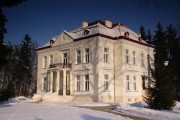 Photo Tadeusz Bielawski
Photo Tadeusz Bielawski Pałac we Wsoli w okresie międzywojennym. Fot. Muzeum Jacka Malczewskiego
Pałac we Wsoli w okresie międzywojennym. Fot. Muzeum Jacka Malczewskiego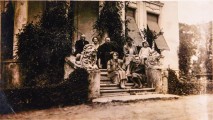 Na schodach pałacu we Wsoli, około 1930 r. Na pierwszym planie Witold Gombrowicz. Fot. Depozyt ML
Na schodach pałacu we Wsoli, około 1930 r. Na pierwszym planie Witold Gombrowicz. Fot. Depozyt ML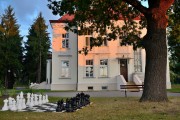 Pałac we Wsoli. Okno na parterze od lewej: pokój Witolda Gombrowicza. Fot. Maciej Kubat
Pałac we Wsoli. Okno na parterze od lewej: pokój Witolda Gombrowicza. Fot. Maciej Kubat Photo Dominik Musiałek
Photo Dominik Musiałek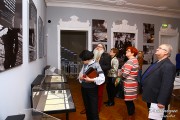 Photo Dominik Musiałek
Photo Dominik Musiałek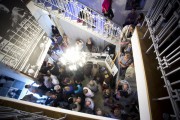 Photo Łukasz Wójcik
Photo Łukasz Wójcik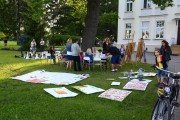 Photo Dominik Musiałek
Photo Dominik Musiałek

Instytucja współprowadzona przez Samorząd Województwa Mazowieckiego oraz Ministra Kultury i Dziedzictwa Narodowego

